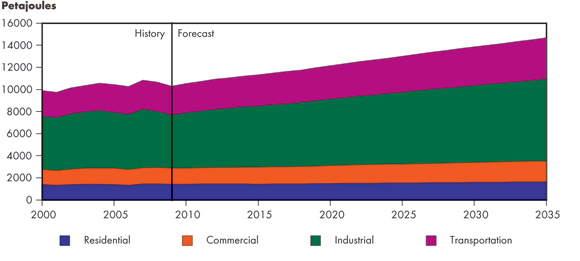ARCHIVED - Fact Sheet - Canada's Energy Future: Energy Supply and Demand Projections to 2035 - Energy Demand Highlights
This page has been archived on the Web
Information identified as archived is provided for reference, research or recordkeeping purposes. It is not subject to the Government of Canada Web Standards and has not been altered or updated since it was archived. Please contact us to request a format other than those available.
Fact Sheet - Canada's Energy Future: Energy Supply and Demand Projections to 2035 – Energy Demand Highlights
Canada's Energy Future: Energy Supply and Demand Projections to 2035 provides a "most likely" Reference Case and four sensitivity cases (based on high and low prices, and fast and slow economic growth) to 2035. The highlights below are based on the Reference Case. For detailed information, please see page 7 of the report.
Energy demand growth slows from its historical pace
- In the Reference Case, total end-use energy demand increases by an average of 1.3 per cent per year. This growth is led by the industrial sector, which grows at an annual average rate of 1.6 per cent, followed by transportation at 1.4 per cent. Residential and commercial energy demand grow at an average annual rate of 0.6 and 1.0 per cent, respectively.
Canadian Energy Demand by Sector, Reference Case

- Overall, energy demand growth slows modestly compared to historical trends. Demand grew at an average of 1.4 per cent per year from 1990 to 2008.
- Despite this modest slowing in aggregate demand growth, the detailed results indicate a marked slowdown in many of the energy demand drivers. These drivers include slowing population growth, higher energy prices, lower than historical economic growth, and enhanced efficiency and conservation programs. Compared to historical growth rates, energy demand growth in the commercial and transportation sectors slows considerably. In the commercial sector, average annual growth falls from 2.0 per cent historically to 1.0 per cent in the projection, while transportation growth falls from 1.9 per cent to 1.4 per cent. Demand growth in the residential sector falls from 0.7 per cent per year over the 1990 to 2008 period to 0.6 per cent from 2010 to 2035.
- Offsetting this slowdown is demand growth in the industrial sector, which made up nearly half of Canadian energy demand in 2010. Robust growth in a number of industries outweighs the declines in energy intensity exhibited by this sector over the outlook period. Industrial energy demand grows at 1.6 per cent per year over the projection period, compared to 1.2 per cent over the 1990 to 2008 period.
- Total energy intensity, measured as energy use per dollar of real Canadian GDP, decreases by an average annual rate of 1.1 per cent over the projection period. This continues the historical trend where energy intensity declined by an average of 1.2 per cent per year from 1990 to 2008.
The report outlines projected demand changes for various sectors including:
Residential sector - Residential is the slowest-growing sector, and its share of total energy demand drops to 11 per cent by 2035 from 14 per cent in 2009.
Commercial sector - By 2035, the commercial sector's share of total demand decreases to 13 per cent down from 14 per cent in 2009.
Industrial sector - The industrial sector makes up the largest share of Canadian end-use energy demand. In the Reference Case, its share of total demand increases to 51 per cent in 2035 from 47 per cent in 2009.
Transportation sector - The transportation sector accounted for 25 per cent of total end-use demand in 2009. Its share of total energy demand remains at 25 per cent throughout the outlook period.
- Date modified:
